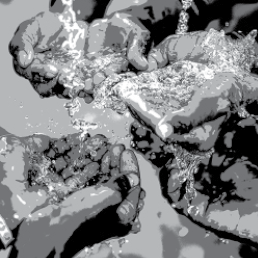Water is essential for life. It is used for individual needs such as drinking, cooking, cleaning, and sanitation, as well as in the human economy—sectors like agriculture, industry, and energy production. However, according to the World Health Organization, 2.2 billion people do not have access to water that meets basic standards of quality. This statistic has only grown since 2010, when the UN General Assembly adopted a resolution that “everyone has the right to safe and clean drinking water and sanitation.” The UN established that governments have a responsibility to ensure that all their citizens have access to this most basic necessity.
Per the resolution, the right to water is “inherent to all human beings, regardless of race, sex, nationality, ethnicity, language, religion, or any other status.” It means that “all peoples, whatever their stage of development and their social and economic conditions, have the right to have access to drinking water in quantities and of a quality equal to their basic needs.” However, it is important to note that the UN does not mean that everyone has the right to an unlimited amount, or water free of charge; rather, people must have access. Because access is essential to public health, for economic development, and for poverty reduction.
In this article, we will focus on the United States along with the UN, because they are among the most prominent in attempting to implement the right-to-water concept. However, so far, for its part the UN has laid out incomplete policy goals on how to implement this lofty ambition. As a member state of the world body, the United States has also had trouble meeting the drinking water needs of all citizens—despite its wealth—50 years after passage of the Safe Drinking Water Act. In this article, we offer recommendations for actions that provide accessible and clean water to as many communities as possible. But we also need to address the potential risks to these strategies to increase their chance of success.
The UN is providing technical assistance to governments, helping raise awareness of the issue, and advocating for the rights of water users through a number of programs and initiatives that improve access to water. For instance, the Sustainable Development Goals are a set of 17 targets that were adopted by the United Nations in 2015. The SDGs are designed to be a blueprint for a better future for all, and they include a wide range of issues—poverty, hunger, climate change, and inequality. Goal 6 is to “ensure access to water and sanitation for all.” This includes not only targets to increase access to safe and affordable drinking water, but also to improve sanitation and hygiene, and to reduce water pollution. The subpoints of this goal include paying special attention to the needs of women and girls and others in vulnerable situations.
SDG 6 goes on to explain how reducing pollution and minimizing release of hazardous chemicals and materials, along with halving the proportion of untreated wastewater, could contribute to safe reuse of water, increasing the available supply. Further regarding water scarcity, the goal discusses increasing water use efficiency across all sectors and ensuring sustainable withdrawals and supply of fresh water. Finally, SDG 6 recommends implementing integrated water resources management at all levels, including transboundary cooperation as appropriate, while protecting and restoring water-related ecosystems, including mountains, forests, wetlands, rivers, aquifers, and lakes. Overall, the UN advocates for expanded international cooperation and capacity-building support for developing countries on the macro level, while strengthening the participation of communities at the local scale.
In 2016, the General Assembly unanimously adopted the resolution titled International Decade (2018-2028) for Action–Water for Sustainable Development, which focuses on the “sustainable development and integrated management of water resources for the achievement of social, economic, and environmental objectives and on the implementation and promotion of related programs and projects.” To elaborate, the UN discusses how water runs through all three pillars of sustainable development, with such resources impacting environmental, social, and economic development. Citing the growing demands from manufacturing, thermal electricity generation (fossil fuel and nuclear power), and domestic use, the UN projects global water demand to increase 55 percent by 2050, making this initiative even more imperative.
The Global Water Partnership is a great example of an existing UN program that is attempting to address water issues through international agreements and related policies. It is a group of governments, businesses, and civil society organizations working to improve water management. GWP’s network of over 3,000 partners is broad and boasts a strong brand in convening sound dialogue, with 20 years of history. Its 13 regional water partnerships have taken on leadership roles in regional processes, South-to-South learning, and cross-boundary coordination.
The United Nations can improve its commitment to fulfilling the human right to water for its member countries by fostering new partnerships among governments, businesses, and civil society organizations. One new strategy would be for the international organization to increase collaboration with local authorities in host countries in order to ensure that the implementation and financing of water policies comes to fruition. Localities have a major role to play in “ensuring adequate financing of equitable access to water and sanitation,” according to the United Nations Economic Commission for Europe. They do so by assessing the need for financial resources, allocating monies from municipal budgets, encouraging service providers to implement specific actions under their own budgets, and more. The UN can help provide resources such as funding and personnel to help local authorities perform financial assessments that contribute to funding for water. Especially for vulnerable and marginalized groups, it is important for the world body to have an on-the-ground understanding of water inequity.
Another way the UN can foster new partnerships is to create a global framework for addressing water stress. This structure would be similar to the 2015 Paris Agreement on climate change, which had countries sign commitments to reducing their carbon footprints by proportional amounts in order to lower atmospheric levels of the greenhouse gas. While there was a UN summit on water in March 2023, it only focused on region-specific actions and did not have the goal of seeking an overarching framework. But such a structure can lay out country-by-country commitments to improving water efficiency and accessibility—which could ensure that governments, businesses, and nonprofits concerned about this issue have a benchmark to work off of.
As its member countries face systemic water issues, it is important for the UN to address a number of difficulties as well as proposed mitigations. Overarching challenges include the fact that the amount of fresh water available on Earth is limited, and the demand is increasing due to population growth, economic development, and climate change. Additionally, some parts of the world are water-rich, while others are water-poor. This means that some people have easy access, while others must travel long distances to meet basic needs.
Many governments do not have adequate resources to make all the investments needed in water management. Water infrastructure is expensive to build and to maintain. As a result, in many developing countries such systems are often in poor condition. In some cases governments simply do not have the money to invest, while in others they choose to prioritize other spending, such as education or health care. A clear example is Greece, which is currently recovering from a deep recession. Over the past decade, the country has been facing twin problems of having insufficient water infrastructure such as treatment capacity as well as regular flooding, meaning that the government does not have enough financial resources to adequately control its water resources. In some cases, countries may also lack the political will to invest in water infrastructure. That can lead to various negative consequences, including shortages, pollution, and disease. While these problems affect most countries, the lack of funding for water infrastructure can acutely contribute to poverty and inequality in developing nations.
In order to address the lack of funding, the UN can encourage governments to raise taxes and tariffs as well as willingly receive foreign aid. The international organization discusses how “improved targeting, better utilization of existing resources including harnessing of synergies between different SDGs, and the mobilization of public and private financing” will help countries fund water, sanitation, and hygiene policies. In order to address cash-strapped local governments, the UN recommends that they first invest in retrofitting existing systems while improving “the collection of municipal taxes” that can generate a revenue stream to refinance loans. In addition, the UN can work with governments to raise awareness of the importance of water infrastructure and encourage citizens to support investment.
In some countries, political instability makes it difficult to implement water projects. Disruptions can make it challenging to plan and execute infrastructure. In addition, these situations can make it difficult for countries to secure funding, as donors may be reluctant to invest in regions where there is a risk their money may be wasted. Moreover, political violence can damage or destroy water infrastructure, making it difficult or impossible to provide this most basic of resources to people who need it.
For example, since the start of the 2011 Syrian civil war, access to safe drinking water has been a challenge affecting millions of people in the country, which now has “up to 40 percent less drinking water than a decade ago,” according to the Red Cross. Political instability can also lead to a lack of trust between different groups of people, which can make it difficult to cooperate on water projects. For example, in the Middle East there is a long history of conflict between Israelis and Palestinians over water resources. According to Amnesty International, this conflict has made it difficult to cooperate on water projects that would benefit both groups of people. In the war with Hamas that started in October, Israel briefly cut off drinking water supplies for residents of the Gaza Strip.
Despite these challenges, there are important actions the UN and governments can take. First, build trust between different groups of people. This can be done through dialogue, mediation, and conflict resolution. It is also important to involve communities in the planning and implementation of water projects. This will help ensure that the projects are responsive to the needs of the local people and that the investments are more likely to be successful.
In addition, there are a number of innovative technologies that can be used to improve water security in areas that are affected by political instability. The UN Conference on Trade and Development points to specific case studies in China, Kenya, and Senegal where NGOs have developed water cisterns, pipelines, and desalination systems as low-cost mechanisms to improve access to water. These technologies can help to make projects more resilient to disruptions and to improve the efficiency of water management.
The World Health Organization has documented that in some cultures, there is a taboo against using water for certain purposes, such as washing hands. In other places, it is considered inappropriate for women to wash their hands after using the toilet. Additionally, some cultures believe it wrong to bathe during menstruation. This can lead to women feeling unclean and uncomfortable, and it can also increase the risk of infection.
By understanding the cultural context, it is possible to design projects that are more likely to be successful. There are various actions that can mitigate the challenges posed by cultural prohibitions. For example, the UN can work with governments and NGOs to inform people about the risks of waterborne diseases. This education contributes to what is known as Water, Sanitation, and Hygiene—WASH—interventions, which occur through schools, community health centers, and other outreach programs across multiple countries.
Fifty years after passage of the Safe Drinking Water Act, there are still many areas in the United States where aging water infrastructure needs repair or replacement, a problem that could lead to shortages, pollution, and waterborne diseases. In the most recent “Report Card for America’s Infrastructure,” the American Society of Civil Engineers estimated there is a water main break every two minutes in the United States, with about 6 billion gallons of treated water lost each day—enough to fill over 9,000 swimming pools. Such losses can go without notice at a national level. But when U.S. communities find their drinking water compromised, it can be big news—as was the case recently in Jackson, Mississippi.
These statistics and major news events signify that crucial parts of our water infrastructure are lacking attention. The United States requires investment from both the public sector and private interests. Regarding the former, there are the federal investments of the Water Infrastructure Finance and Innovation Act and Drinking Water State Revolving Fund. However, with the American Water Works Association estimating that national water needs will total over $1 trillion by the end of the decade, current funding only accounts for just over 60 percent of that amount.
New measures from the federal government include the Biden administration setting aside $15.4 billion to enhance the American West’s resilience to drought through the Inflation Reduction Act and Bipartisan Infrastructure Law. The focus on the western region is due to the consistent droughts and water issues it faces, with the federal government declaring a “tier 2” shortage of the Colorado River Basin and thus reducing Arizona’s water share by 21 percent, Nevada’s by 8 percent, and Mexico’s by 7 percent. Specifically, the administration plans to provide up to $233 million in water conservation funding for the Gila River Indian Community, up to $36 million for water conservation in the Coachella Valley. and $20 million for four small surface water storage and groundwater storage projects in California and Utah, including one near the Salton Sea. These investments are a critical step toward ensuring that everyone in the country has access to clean water.
There is still a long road ahead for the United States to provide efficient and accessible water systems to its entire population. There is a particular impetus for state governments that have declared their own “human right-to-water” policies. These states include: California, New York, Rhode Island, and Montana. Thus, ideas to actualize this right include coordinated zoning efforts by state and local governments as well as regionalization. Regarding the former, state governments should be allocating additional funding for water expenses. In 2020, the Urban Institute estimated that California spent $32 million on water utilities, matched with a total utility revenue of $910 million; that resulted in a ratio of 3.52 percent. New York spent $77.9 million on water utilities with a total revenue of $8 billion, leading to a ratio of 9.72 percent. States can increase these ratios by adopting model ordinance language targeted at natural resources, and writing zoning ordinance provisions that aim to improve environmental protection.
Concerning regionalization, American communities can partner with their neighbors to spread water costs over larger populations. By consolidating multiple water systems, communities can utilize adjacent systems’ excess capacity, set up mutual-aid agreements, work toward implementing similar rates, plan and build interties, and evaluate governance options. An example of this concept is the Lowcountry Regional Water System, which is a consortium of five small towns in South Carolina that have utilized regionalization to reduce overall water costs. The federal government should be encouraging state governments to explore regionalization efforts where appropriate.
The United States faces many risks trying to achieve these water policy goals, including cost, complexity, regulatory hurdles, and political opposition. The cost of these projects can be a major barrier to investment. In addition, these projects are often complex and can involve a number of different stakeholders, which can make it difficult to plan and execute. Water infrastructure projects are often subject to a number of rules, which can add to the cost and complexity. Specifically concerning regionalization, there are obstacles including competition among existing water utilities, legal issues concerning water rights, the technical feasibility of interconnecting the systems, and concerns over allocation of costs.
Streamlining regulations and building political support for water policies are ways that the U.S. government can mitigate these risks. Streamlining can help to reduce the cost and complexity of water infrastructure. An example is 33 U.S.C. 1344(f), an amendment in the Clean Water Act. It states that “the secretary may, after notice and opportunity for public hearing, issue general permits on a state, regional, or nationwide basis for any category of activities involving discharges of dredged or fill material.” A general permit is an authorization mechanism that allows construction to streamline certain activities—such as discharges and dredging up of materials.
Additionally, building support for water infrastructure can help to overcome political opposition to these projects. This past March, Senators Susan Collins (R-ME) and Tammy Baldwin (D-WI) introduced the bipartisan Healthy Drinking Water Affordability Act that aims to provide 43 million predominantly rural households with water testing kits to help protect from emerging contaminants like PFAS, the “forever chemicals” that are now turning up in drinking water systems nationwide, raising public health concerns.
The right to water is a fundamental human right, but for billions of people around the world, there has been insufficient action to make this right a reality. Every day, millions of people have no choice but to drink contaminated water, which can lead to deadly diseases like cholera and typhoid. Children are especially vulnerable to the detrimental effects of unsafe water—some 72,000 children under five die annually from these diseases.
The UN and United States have significant roles in helping the world achieve universal access to water. But we all have a role to play in ensuring that everyone has access. We can raise awareness of the issue, advocate for the rights of water users, and support organizations that are working to promote the right to water. By working together, we can make a difference and ensure that everyone has the water they need to live a healthy and productive life.


